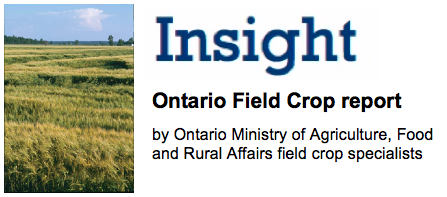Seasonal Summary for Corn
by GREG STEWART
April of 2014 proved to be cool and wet and provided virtually no opportunity to plant corn. However, beginning May 1, things turned around and approximately 40% of the corn acreage was planted by May 12th. Frequently, rainy weather moved across much of the western part of the province in the period May 13 to May 25 and the remaining 60% of the acreage was mostly planted in the window from May 26 to June 3. Total acreage planted in Ontario was 1,875,000 which was down about 15% from 2013. Some of this reduction was market force driven and some caused by less than optimum planting windows. The delayed planting resulted in growers switching to shorter season hybrid or to soybeans. Generally rainfall and soil moisture was adequate to promote good emergence in both the early planted and the later planted corn.
Early season leaf injury to corn plants from herbicide or nitrogen (UAN) applications was particularly noticeable in 2014. This was due to thinner leaf cuticles as a result of more cooler, cloudier, high humidity conditions than normal in the May/June period.
The OMAFRA Soil Nitrate Survey conducted on June 10 resulted in soil nitrate levels that were lower than average. On the medium textured soils (loams and silt loams) that had not received fertilizer nitrogen or manure, and where the previous crop was not red clover or alfalfa, soil nitrate levels were below the long term trend. The average from these soils this year was 9.8 PPM nitrate, compared to an historical average of 11.0 PPM and compared to 12.2 PPM in 2012 (warm spring) and 9.5 PPM in 2011 (cool, wet spring).
June weather was conducive to extensive field work allowing for the completion of planting and rather unencumbered spraying and nitrogen applications. By July 1 the Ontario corn crop, on average, rated from good to very good.
Cool weather in July slowed crop development down at a critical time. During the last part of July most areas recorded CHU accumulation 15% below normal and in some areas accumulation was almost 25% below the 30 year average. On the positive side frequent rainfall and virtually no heat or drought stress resulted in very successful pollination and as a result kernel counts were quite high.
With the combination of later planting and a cooler than average July it was clear by mid-August that the 2014 corn crop was significantly delayed and that grain filling was going to need to continue into September and beyond. Fortunately most areas escaped a killing frost until well into October, the main exception being extreme eastern Ontario where temperatures dipped into the -2 to -4 C range on September 19th.
The delayed grain filling trimmed what might have been record breaking yields, reduced test weight on the majority of the grain corn in the province, and significantly increased harvest moistures and drying costs. Stake holders were reminded that based on earlier research the feed value of lower test weigh corn remains quite competitive to typical #2 corn. However, the very high percentage of lower test weigh corn in some areas of the province will continue to represent marketing challenges.
The OMAFRA Grain Corn Vomitoxin Survey resulted in 9 % of the 202 samples testing 2.0 PPM or greater for DON. These results showed an increase in vomitoxin levels compared to the 2013 survey were only 2% of the samples registered a DON level of more than 2.0 PPM but still indicated a relatively clean crop from an ear mould toxin perspective. In particular the samples with high DON concentrations in this year’s survey (>5.0 PPM) did appear to be closely associated with ears that had Western Bean Cutworm feeding damage that fostered the development of ear moulds and toxin development.
Northern Corn Leaf blight was evident in more areas and at higher infection levels than average, continuing a trend for some of the known resistance to be breaking down and to increase the risk posed to corn yields by this disease.
The Ontario provincial corn yield for 2014 is 160.9 bu/acre. This will position 2014 as the second highest provincial corn yield of all time.
| Attachment | Size |
|---|---|
| 50.53 KB |



